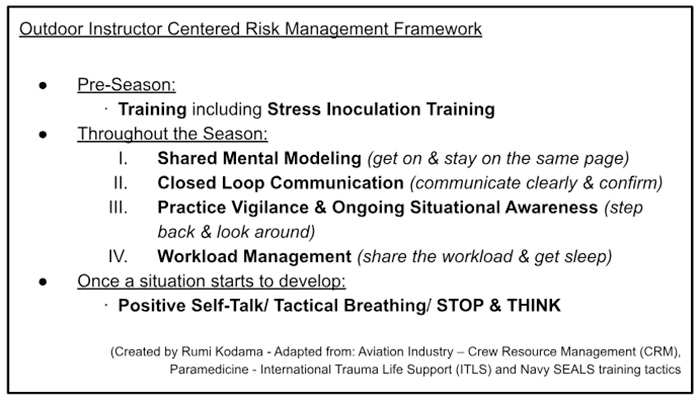A Risk Management Framework for Outdoor Leaders
Learning Objective
To introduce the core elements of the Risk Management Framework for outdoor leaders.
Introduction
Risk management goes beyond tying knots correctly and double-checking harnesses; it is embedded in the way we communicate, apply technical expertise, manage stress and make decisions every day. The Outdoor Instructor-Centered Risk Management Framework provides a guiding set of principles and daily practices that help us think about and manage risk within all aspects of our work as outdoor leaders.

The RM Framework is applied in three ways that work in complement with each other to mitigate risk:
- Full Season (macro scale): The Framework starts with pre-season training, as this is where risk management begins to take shape. During the season, the four core elements of the framework are used on an ongoing basis to manage and mitigate program risks.
- In an Emergent Situation (micro scale): The framework can be reapplied when emergent situations develop in the field. When situations arise, practicing the four core elements of the framework helps contain and manage the situation, preventing further deterioration.
- Stress Injury Mitigation: Finally, the framework is applied proactively as a tool for mitigating Stress Injury and Burnout. In outdoor settings, stress injuries often stem from prolonged exposure to continuous stress and the accumulation of daily stresses without sufficient recovery. Effective risk management lowers stress levels, reducing the likelihood of stress injuries and burnout.

Risk Management Throughout the Season
Risk management throughout the season involves using a proactive approach to identify, assess, and mitigate potential risks and uncertainties that could impact activities planned for the season.
During pre-season, practice and training should focus on and include Stress Inoculation.
Throughout the season, field staff should focus on Shared Mental Modelling, Closed Loop Communication, Workload Management, and should Practice Vigilance and Ongoing Situational Awareness.
When a situation starts to develop, field staff should engage in Positive Self-Talk, Tactical Breathing, and STOP & THINK.
There is more information about these concepts and their practice below.
Pre-Season: Stress Inoculation
Stress Inoculation Training (SIT) is designed to help individuals build effective coping strategies and resilience through exposure to stressful situations in a training or practice environment.
Leading groups in the outdoors is a complex job requiring critical thinking in stressful situations; tasks can be both physically and psychologically intense. Training that replicates field scenarios progressively and in a controlled manner refines emergency response and general risk management skills. It also readies individuals to manage stress, enabling more conscious and logical decision-making processes under pressure, thereby enhancing overall risk management effectiveness.
Four Key Steps in Effective Stress Inoculation Training:
1. Familiarization: Become familiar with stressors that could be part of a given situation in a controlled and well-managed manner.
2. Progressive and Cumulative Exposure: Apply stressors that are challenging yet not overwhelming, keeping within the ‘stretch zone’ for tolerable periods without entering the ‘panic zone’.
3. Anxiety Management: Each training stage should prevent or manage anxiety buildup. Strategies may include ‘time outs’ and safety vetoes (see Culture of Dissent), pausing for discussion or debriefing, and incorporating breaks.
4. Skill Development: Each activity should contribute to the development of required technical skills so that they become fluent and intuitive.
For example, an aspiring sea kayak guide must learn assisted rescues in calm waters without time constraints, complexities or pressures, before needing to perform them when a participant is immersed in cold water on a windy and exposed crossing. SIT only works when stressors are gradually introduced – individuals must first perform the skills in a non-stressful environment.
For more, read about Learning Zone Model Theory.
The SIT Approach
Intentionally putting ourselves in uncomfortable or complex and stressful situations helps with SIT. We want to push into our learning or “stretch” zone in a controlled and supported environment so that when we are in a similarly stressful situation while in a leadership role we won’t slip into our panic zone. Having experienced trainers present as a ‘safety net’ also allows for failures to happen in a controlled setting. The goal is to be able to safely fail – not be “fail safe.”
Outdoor activities provide a unique and natural setting for applying the principles of Stress Inoculation. Engaging in activities like hiking, paddling, and camping exposes individuals to various stressors including unpredictable weather conditions, group dynamics, physical challenges, and unfamiliar environments. These stressors can be seen as opportunities to practice the skills learned.
For example, facing the uncertainty of weather during a camping trip can provide individuals with a chance to implement relaxation and mindfulness techniques, positive self-talk, and problem-solving skills in a practical context.
Additionally, outdoor activities often require individuals to step out of their familiar zones and confront fears or anxieties. This aligns with the gradual exposure approach in SIT, where individuals are gradually exposed to stressors in a controlled manner. Overcoming challenges during outdoor activities fosters a sense of accomplishment and builds self-efficacy, further enhancing an individual’s ability to manage stress and anxiety.
For outdoor leaders, pre-season SIT can take the form of rescue and incident response scenarios, crisis drills, and working in conditions beyond the level of challenge and skill that they will be leading groups. Most outdoor leader and instructor certification programs involve elements of SIT in their curriculum so that candidates are prepared to manage stress and respond by engaging in ‘worst case scenario’ simulations.
When SIT is used thoughtfully and gradually, engaging in outdoor challenges can help us to develop our skills, resilience, effective coping mechanisms, and a greater sense of control over stress and anxiety in preparation for a season of leading groups in the field.
Checkpoint: Stress Inoculation
Essential Skills of the Risk Management Framework
Closed Loop Communication
Closed loop communication is a strategy ensuring that the intended message is accurately received and understood. The sender confirms understanding by hearing the receiver repeat the message or instruction, effectively “closing the loop.” This process, which doesn’t demand additional time and can, in fact, save time, enhances clarity and minimizes misunderstandings, especially in critical or complex interactions.
Example: Sender: “Can you prep lunch by the big stump?” Receiver: “Yup, I can prep lunch by the big stump.” Sender: “Thanks!”
This simple yet effective communication method ensures that instructions are not only received but also correctly interpreted, contributing to streamlined and effective operations.
Practice Vigilance & Ongoing Situational Awareness
Practicing vigilance and ongoing situational awareness requires a continuous assessment and reassessment of the group, the surroundings, and any evolving conditions or situations enabling informed decision-making and responses. It can also be fostered in participants, creating an environment where anyone can notice a situation, say STOP or ask WHY? (See Culture of Dissent)
Shared Mental Modelling
Shared mental modeling refers to the process in which individuals within a group or team develop a common understanding of a situation, problem, or concept.
This shared understanding enables better communication, coordination, and collaboration among team members by aligning perspectives and facilitating coordinated decision-making. It helps us “get on the same page” when working in dynamic outdoor environments.
Workload Management
Workload management involves distributing tasks, resources, and responsibilities to individuals or in order to optimize productivity while preventing overwhelm or burnout. It involves regular check-ins with the team to assess their functioning and a thoughtful consideration for the fair distribution of tasks, recognizing that fair doesn’t always mean equal. This includes getting enough sleep, adequate breaks and down time.
Understanding your team is essential—know their capabilities and limitations. Effectively managing workloads contributes to a balanced and sustainable team dynamic.
Once a Situation Starts to Develop
Leading outdoor activities can present potentially stressful situations, and a proactive approach is essential to ensure a successful experience for all participants. For instance, unexpected weather changes might arise, challenging the safety and comfort of the group. Encountering unfamiliar terrain, wildlife encounters, or participants experiencing discomfort are also scenarios that might induce stress. When such situations unfold, employing effective stress management strategies becomes crucial for navigating challenges skillfully.
Positive Self-Talk: Positive self-talk is an internal dialogue that emphasizes optimistic and affirming thoughts. It involves consciously directing your thoughts in a constructive and uplifting manner, promoting a positive mindset. Positive self-talk can have various benefits, including improved mental well-being, increased confidence, and enhanced resilience.
Tactical Breathing: Tactical breathing is a controlled breathing technique that involves specific patterns of inhalation, breath holding, and exhalation. The purpose is to regulate the autonomic nervous system, particularly the stress response, by slowing down the breathing rate and promoting relaxation and clear thinking.
Some Basic Tactical Breathing Techniques
Box Breathing
- Inhale: Take a slow and deep breath through your nose. Inhale for a count of four seconds, allowing your lungs to fill with air.
- Hold: Hold your breath for a count of four seconds. During this pause, focus on the stillness and the sensation of having a full breath.
- Exhale: Release the breath slowly and completely through your mouth for a count of four seconds. Ensure that the exhale is steady and controlled.
- Pause: After exhaling, pause for another count of four seconds before starting the cycle again.
5 Fingers Breathing
- Hold one hand up and trace your hand with a finger of the opposite hand. As you trace a finger towards the tip of the finger breathe in, as you trace the finger down to the web breathe out. Trace nice and slow.
Belly Breathing
- Take a few big slow deep breaths into your belly, letting your shoulders relax. These two actions directly trigger your vagus nerve to lower your heart rate and trigger the relaxation response. This is also known as diaphragmatic breathing.

Stop and Think
The practice of training oneself to ask “Stop and Think” questions is a valuable cognitive strategy that promotes thoughtful and deliberate decision-making. Pausing to reflect and pose open-ended questions before taking action can have several benefits:
- Cognitive Engagement:
- Asking “Stop and Think” questions engages cognitive thinking processes. It prompts individuals to activate their analytical and reflective capacities, fostering a more deliberate approach to problem-solving.
- Impulse Control:
- This approach helps in controlling impulsive reactions. It allows for a moment of reflection rather than an immediate response driven by emotion or instinct.
- Consideration of Options:
- Open-ended questions like “What are the potential outcomes?” or “What resources can I utilize?” prompt individuals to consider a range of possibilities. This broader perspective helps in evaluating options and making more informed decisions.
This approach fosters a deeper understanding of the situation and the options available, enabling individuals to respond with greater clarity and care.
Example “Stop and Think” Questions
Combining positive self-talk, tactical breathing, and “stop and think” questions creates a holistic strategy for effectively managing evolving situations, promoting better decision-making, and fostering emotional resilience. When faced with a challenge, initiating positive self-talk helps shift one’s mindset from anxiety to empowerment. Simultaneously, engaging in tactical breathing calms the body’s stress response, fostering clarity and rational thinking amid adversity.
Integrating the “stop and think” technique further enhances this approach. Pausing to evaluate the situation, asking pertinent questions like “What are the immediate risks?” and “What are my available resources?” encourages a methodical assessment of the circumstances.
By considering potential outcomes and solutions, individuals are better equipped to make informed decisions. This comprehensive strategy equips individuals with a multi-faceted toolkit to navigate stress: fostering mental strength, physiological composure, and strategic decision-making that collectively contribute to the successful navigation of challenges; managing risk and while also managing stress.

References
Ashokan, A., Sivasubramanian, M., & Mitra, R. (2016). Seeding Stress Resilience Through Inoculation. Neural Plasticity. Retrieved September 13, 2023, from https://link-gale-com.proxy.eclibrary.ca/apps/doc/A513640931/PPPC?u=ko_acd_can&sid=bookmark-PPPC&xid=e1bbe9ee
Holland, K. (2018). Positive Self-Talk: Benefits and Techniques. Healthline. https://www.healthline.com/health/positive-self-talk
mentalhelp.net. (2019, November 5). Stress Inoculation Therapy. Mental Help. https://www.mentalhelp.net/stress/inoculation-therapy/
Saunders, T., Driskell, J.E., Johnston, J.H., & Salas, E. (1996). The effect of stress inoculation training on anxiety and performance. Journal of occupational health psychology, 1 2, 170-86 .
Weller, C. (2013, April 1). Stress Inoculation Training in Tactical Strength and Conditioning. National Strength and Conditioning Association. Retrieved September 13, 2023, from https://www.nsca.com/education/articles/tsac-report/stress-inoculation-training-in-tactical-strength-and-conditioning/
A Stress Injury is an occupational injury that occurs in the presence of overwhelming stress and exposure to psychological stress in the line of duty.
A state of emotional, mental and physical exhaustion brought on by prolonged or repeated exposure to stress.
A psychological technique designed to help individuals better cope with and manage stress and anxiety by exposing them gradually to controlled levels of stress.
The process by which individuals within a group or team develop a common understanding of a situation, problem, or concept.
The use of effective communication to minimize misunderstandings and differing interpretations
Distributing tasks, resources, and responsibilities to individuals, or in order to optimize productivity while preventing overwhelm or burnout.
Constantly monitoring and understanding relevant information and dynamics in a given environment to make informed decisions and responses.
Positive Self-Talk involves consciously replacing negative or anxious thoughts with optimistic and constructive statements. This may take the form of verbally saying positive affirmations.
A technique involving controlled inhalation and exhalation, which helps regulate the body’s stress response.
A technique that involves stopping whatever you’re doing to actively ask yourself questions (think) about current activities and what your next steps should be.
One's belief in one's ability to succeed in specific situations or accomplish a task.
The vagus nerve is a major cranial nerve that plays a key role in regulating various bodily functions, including heart rate, digestion, and stress responses.



